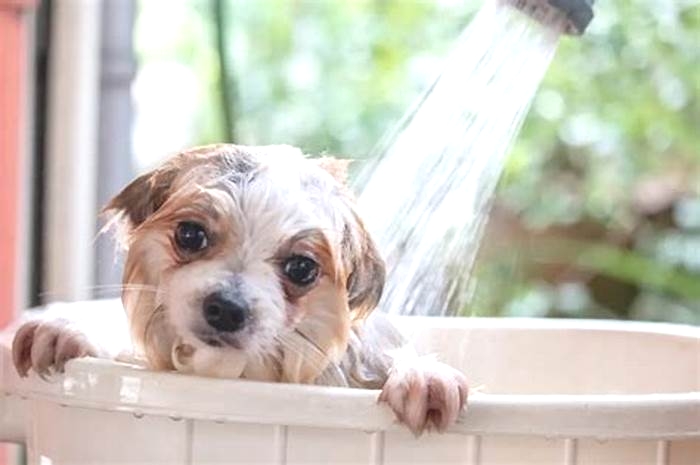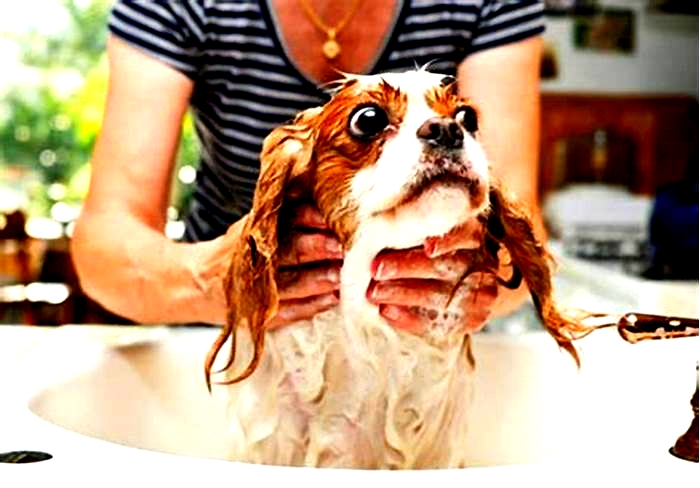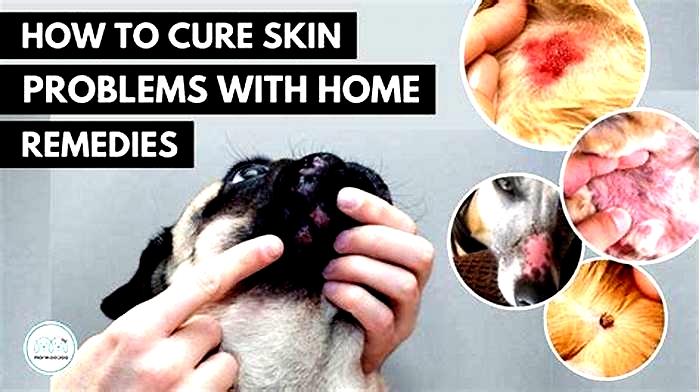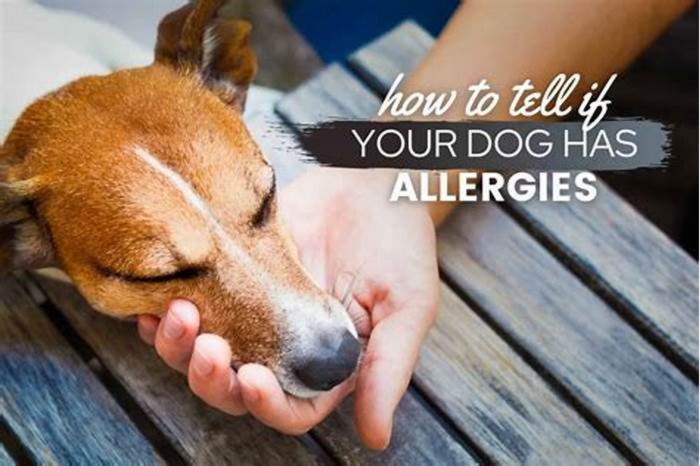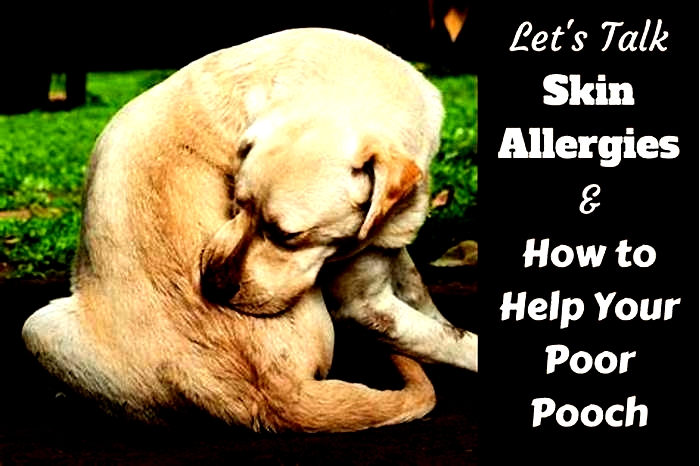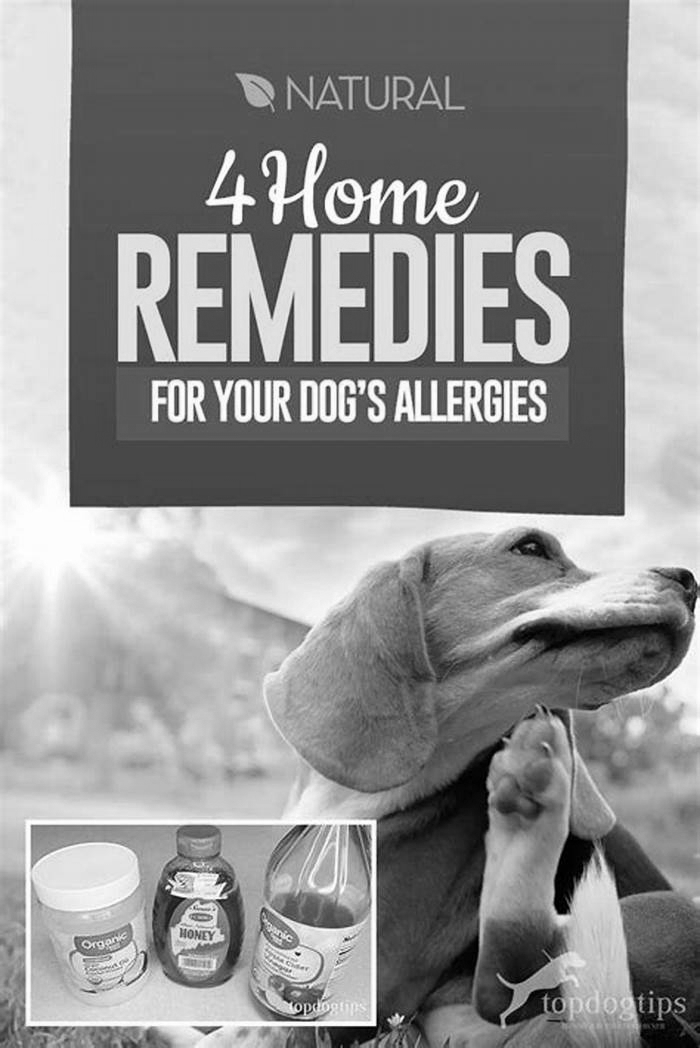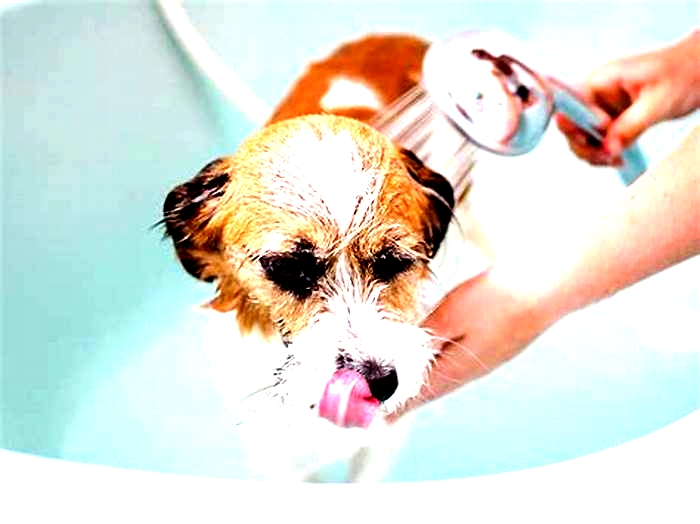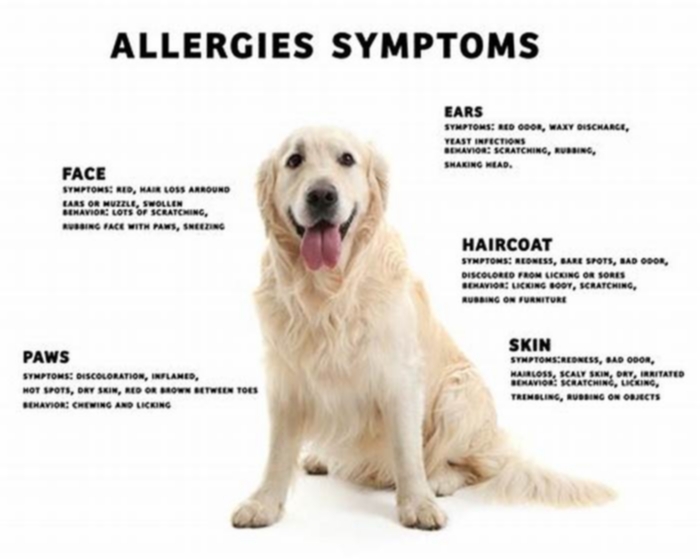How often should you wash a dog with skin allergies
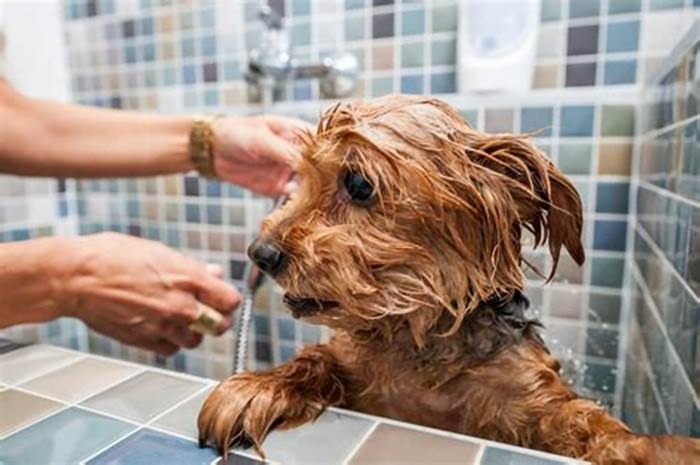
How To Wash A Dog With Allergies
Its tough to watch your dog scratch and whine because they are suffering with skin allergies. Washing can be a very useful tool in managing this unfortunate condition and, if done correctly, can become a pleasant experience for both pet and owner.
Bathing your dog with skin allergies once or twice a week with a suitable shampoo can be a useful way to help alleviate symptoms such as inflammation and itching.
However, it is important that this is done correctly to avoid making your dogs condition worse.
Skin allergies in dogs can be difficult to treat, and veterinary advice should always be sought if your dogs condition is not resolving or is worsening.

What are skin allergies in dogs?
Allergies are common in both humans and animals, and can occur for a variety of reasons. An allergy is when the bodys immune system responds inappropriately to a substance, causing a reaction to something which normally would not pose a threat to the body.
The substances which trigger an allergic reaction may be different types of food, insect bites, medications, or environmental triggers such as dust or pollen. The allergic reaction to this substance can cause a wide range of symptoms which may affect different body systems including the skin.
Skin conditions are one of the most common reasons that owners seek veterinary attention for their dog, and skin allergies are the most common type of allergic reaction in dogs.
What are the symptoms of dog skin allergies?
Dogs with skin allergies, also known as canine allergic dermatitis, may show a range of different symptoms, including:
- Itching this may be localized (in one area) or generalized (over the whole body)
- Licking normally focused on the paws
- Chewing particularly at sore or infected areas of skin
- Face rubbing
- Inflammation of the skin the skin may look red and sore initially, and may become thickened over time
- Skin sores or infections
- An unpleasant skin odor
- Dry skin and/or dandruff
- Rashes or raised lumps on the skin
- Hair loss
What causes skin allergies in dogs?
Many things may trigger an allergic reaction in dogs, including environmental pathogens, insect bites and dietary intolerances:
- Environmental pathogens: Mold, dust and pollens are all types of environmental pathogens which may trigger an allergic reaction. Sometimes these triggers may be seasonal, such as pollen; others are present all year round.
- Insect bites: Some dogs are allergic to flea saliva, leading to a condition known as flea allergic dermatitis.
- Dietary allergies or intolerances: Dogs are rarely considered to be truly allergic to different foodstuffs, however some do commonly develop intolerances to certain diets over time which will lead to similar symptoms as an allergic reaction.
The simplest way to treat an allergy is to remove the cause, for example by modifying the diet. If you suspect that your dog has an allergy then veterinary advice should always be sought; they may do tests to help to identify the cause of the allergy.
Sometimes it can be very difficult or even impossible to pinpoint the exact cause of the allergic response, even with extensive testing; in these cases the allergic response will need to be treated symptomatically.
Why washing helps a dog with allergies
Skin allergies upset the natural balance of bacteria and yeasts on the skin. Normally the immune system maintains this balance but the immune response to allergens disrupts this delicate balance.
This leads to the itchiness which many dog with skin allergies suffer from. When the dog scratches to relieve this itching they may cause tiny tears in the skin surface, allowing these bacteria and yeasts to penetrate the uppermost skin barrier and cause infection.
Washing a dog with allergic skin disease will help to relieve symptoms by removing allergens, rehydrating the skin and rebalancing the levels of bacteria and yeast on the skin surface. Regular and effective washing will help to reduce the incidence of secondary skin infections in dogs with skin allergies.

How to wash a dog with skin allergies
There are many factors to consider when washing a dog with allergies, including:
- When should you wash your dog?
- How often should you wash your dog?
- Should shampoo be used?
- What method should you use to wash your dog?
When should you wash your dog?
If your dog has a new skin condition, then it is very important to seek veterinary advice before taking steps such as washing your dog, especially if you suspect your dog may be suffering from a skin infection or has inflamed skin.
The earlier your dogs skin condition is investigated then the sooner a treatment plan can be put into place. Veterinary advice will also help to identify and hopefully remove the cause of the allergic reaction; you can then start to wash your dog to help to alleviate their symptoms.
You may have been dealing with your dogs skin allergies for some time with the help of your veterinarian, in which case you will become more familiar with identifying when your dog is ready for a wash.
You might notice that the skin is starting to become dry and showing dandruff, or your dog is beginning to scratch more than normal. It is best to wash your dog as soon as possible when symptoms start to worsen, in order to prevent excessive scratching which may lead to a skin infection.

How often should you wash your dog?
Each dog will be very different, and it is important to tailor your washing routine to suit your own dogs needs. As a general rule, a weekly bath should be sufficient to relieve soreness and itching in most dogs suffering from a skin allergy.
You can also remove allergens from your dogs coat by wiping them down with a warm damp cloth; it is a good idea to make this part of your daily routine, ideally when you return from exercise or outdoor activity with your pet.
Washing your dog too frequently may actually worsen their condition, by causing the skin to become dry and flaky. Washing is also not recommended if certain types of flea treatment have been used, so ensure that you check the instructions carefully.
It is important to be mindful of how enjoyable your dog is finding the washing experience; if the skin is particularly sore or inflamed then washing may cause considerable discomfort. In these cases veterinary advice should be sought.
Should shampoo be used?
This is one of the most important factors to consider when washing a dog with skin allergies; using the wrong product may make the condition worse or even be harmful to your pet. It is important to seek veterinary advice before selecting a shampoo.
Your dog may be suffering from a secondary bacterial or yeast infection, in which case your veterinarian may advise the use of an antibacterial or antifungal shampoo.
For routine maintenance something like an oatmeal shampoo can be very effective for rehydrating dry skin and reducing itchiness. Commercial oatmeal shampoos are available but it is also a very simple shampoo to make at home simply grind oats in a blender until they are a fine powder, and add to your dogs bath water.
Another natural product which can be useful to soothe skin allergies is coconut oil; use after a bath on localized areas of dry skin and smooth over the coat.

What washing method should you use to bathe your dog?
It is vital that having a wash is an enjoyable, relaxing and soothing experience for your dog. A dog with skin allergies may require a weekly wash for the rest of his or her life, so it is better for everyone if it is a pleasant experience.
Watch how your dog responds to each step of the process; if they are showing signs of discomfort or distress then modify your technique to make them more comfortable.
Before you wash your dog, make sure that they are settled and calm to give you the best chance of a relaxing washing experience. Ensure that the water is lukewarm; water which is too warm or cold will be uncomfortable for your dog particularly on sore or irritated skin.
Placing a mat or towel in the bottom of the bath can help to prevent them slipping on the surface, and a jug can be used to pour water over the body rather than immersing your dog fully underwater.
Shampoos should be smoothed over the skin and coat and very gently rubbed in using a massaging motion. After the shampoo has been on the skin for the recommended length of time ensure that it is completely rinsed from the coat.
Take your time over drying your dog, as again this could potentially be a distressing and painful experience for a dog with sore or inflamed skin. Avoid rubbing the coat and skin with a towel; instead pat gently with the towel and squeeze any excess water from the fur.
This can be a good time to add a small amount of coconut oil to the fur, using the towel to distribute it. Allow your dog to rest somewhere warm and quiet until they are completely dry, and give them a gentle brush to ease out any tangles and knots.
Bathing Recommendations for Dogs with Allergic Skin Disease
Allergic skin diseases affect a lot of dogs and bathing may be recommended as a part of the treatment plan. Bathing may reduce allergen exposure, treat infections, reduce itch, or support the epidermal barrier.
Follow these six bathing steps to help your furry friend control allergic skin disease.
1. Soaking
Always use warm to slightly cool water to wet the entire coat. Then apply any shampoo. Warm/hot water may irritate some dogs with infected or inflamed skin.
2. Bathing
For dirty pets, use a maintenance shampoo to remove dirt and then apply medicated shampoo. Lather lesion areas first. Some shampoos require a specific contact time with the skin/lesion to get the full therapeutic effect. Aim for 10 minutes of lather time. But remember, a five-minute bath is better than skipping a bath.
3. Rinsing
Rinse shampoo thoroughly until the water runs clean. Focus on areas where shampoo may get trapped (armpits, groin, under tail, or between toes). Residual medicated shampoo left on your dogs skin may be irritating.
4. Conditioners
Depending on the condition being treated, your veterinarian may recommend a cream rinse or conditioner.Most are applied, worked into the skin and hair coat, then rinsed thoroughly. Some are intended to be left in.
5. Drying
We recommend towel drying. Warm blow dryer air will dehydrate the skin and may irritate dogs that have allergies or an infection affecting their skin. If air is needed, you should not use heat and be sure not to over dry.
6. Clipping
For medium- to long-haired dogs, clipping the hair coat facilitates successful bathing programs. Shorter hair allows topical medications and shampoos to penetrate to the skin and do their job.
By Lauren Pinchbeck, DVM, MS, Diplomate, ACVD |
How Often Should You Bathe Your Dog? (Plus 8 Bathing Tips)
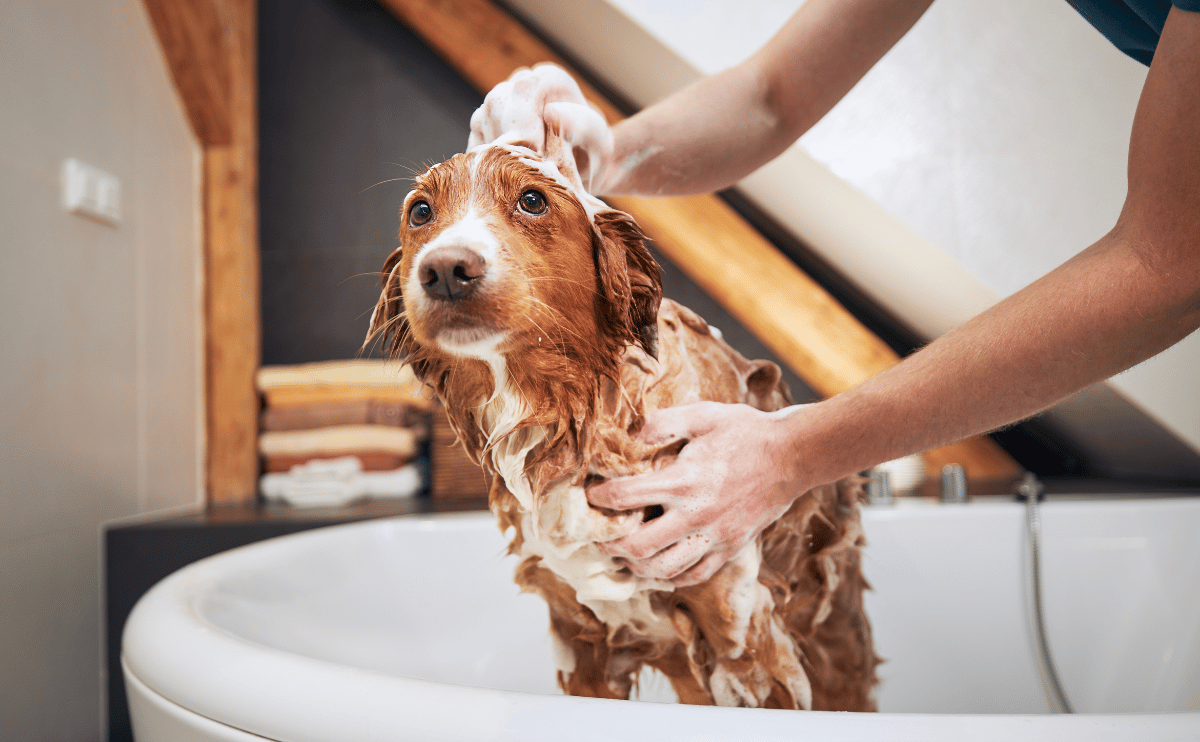
Splish splash, does your dog need a bath? Most humans shower once daily, but how often should you wash your dog? Well get down and dirty with the facts on how to keep your furry friend looking fresh and clean to ensure a happy, healthy pup.
How Often Should I Bathe My Dog?

According to an Honest Paws study, 56% of pet parents dont bathe their dogs as frequently as they should, and 60% use the sniff test when deciding when its bath time.
Bathing your dog isnt just good for their hygiene. Its also an excellent chance to check for unusual scratches, bumps, fleas, and other abnormalities. These things are easier to see when their hair is wet and flat against their body.
But how often should you wash your puppy? There are a few factors that determine your pups bath routine:
- Hair Length: Does your dog have long hair that can trap dirt and debris? Or are they short-haired and less susceptible to getting grimy?
- Activity Level: A dog who is mostly indoors and stays out of trouble when theyre outside is probably cleaner than a dog who likes to dig holes, play in the park, roll in waste, or go swimming.
- Allergies and Skin Conditions: Some dogs have skin allergies or other health conditions that make them prone to needing a bath more or less frequently. Learn more about dog skin allergies.
At a minimum, bathe your dog at least once every three months.You can wash your dog as frequently as every other week (with a gentle shampoo, it could be even more frequent). When in doubt, use your judgment if your dog starts to smell, its probably time for a bath. Its also a good idea to check with your veterinarian about how often to bathe your dog.
Can I Bathe My Dog Once A Week
Is it bad to bathe your dog every week? Or wondering can I bathe my dog twice a week? Its not recommended. Your dog needs natural oils produced by the skin to promote hair growth and good overall skin and coat health. Overbathing your dog could strip the skin of these natural oils, leading to irritation and dryness. So dont overdo it!
9 Benefits Of Bathing Your Dog
Bathing your dog is an essential aspect of their overall health and well-being. While dogs are generally good at grooming themselves, regular baths provide several benefits:
- Removal of Dirt and Debris: Bathing helps remove dirt, debris, and loose hair from your dogs coat. This is particularly important for dogs that spend time outdoors and may come into contact with allergens, parasites, or pollutants.
- Prevention of Matting: Regular baths help prevent the matting of your dogs fur, especially in breeds with long or dense coats. Matting can lead to skin irritation and discomfort.
- Reduction of Odors: Dogs can develop odors over time due to natural oils, outdoor activities, or skin conditions. Bathing helps control and reduce these odors, keeping your dog smelling fresh.
- Flea and Tick Prevention: Regular bathing, especially with flea and tick shampoos, can help prevent infestations. Its essential to use dog-safe products to avoid skin irritation and adverse reactions.
- Removal of Allergens: Dogs can be allergic to certain substances, and their skin may react to allergens present in the environment. Bathing helps remove potential allergens and provides relief for dogs with sensitive skin.
- Early Detection of Issues: Bathing allows you to closely examine your dogs skin, coat, ears, eyes, and other body parts. This regular inspection helps you detect any abnormalities, lumps, bumps, or signs of infection early on.
- Positive Interaction: Bathing provides an opportunity for positive interaction and bonding between you and your dog. It helps build trust and reinforces the relationship between pet and owner.
- Positive Exposure to Grooming: Regular bathing and grooming from an early age help your dog become more accustomed to the grooming process. This can be particularly beneficial for grooming procedures that may be necessary for their health, such as nail trimming and ear cleaning.
- Cooling Effect: In hot weather, a cool bath can help regulate your dogs body temperature. However, its important not to bathe your dog too frequently, as excessive bathing can strip away natural oils and lead to dry skin.
While bathing is important, its crucial to strike a balance and not overdo it. The frequency of baths depends on your dogs breed, activity level, and overall health. Consult with your veterinarian to determine an appropriate bathing schedule and to choose the right products for your dogs specific needs. Additionally, always use dog-safe shampoos and conditioners to avoid skin irritation.
CBD Oil Can Help Calm A Dog Before Bath Time
Many dogs become anxious when its time to hop in the tub. To help ease your dogs anxiety, you could give your dog a little CBD oil or a CBD-infused treat. Give your vet a call before administering any CBD products, and talk to them about if your dog is a good candidate for CBD. We also recommend contacting the products manufacturer to check with them first.
How To Bathe A Dog: 8 Bathing Tips
How do you bathe a dog correctly? It can be tricky trying to tame your pup in the tub while also washing them. Thanks to these tips, giving a dog a bath is easier than you think. Try these simple steps to ensure you have a successful bath time with your furry friend.
1. Buy Shampoo & Other Supplies
Use a dog-specific shampooto prevent suds from stinging your dogs eyes. We recommend you use a hypo-allergenic and all-natural shampoo to reduce potential skin irritations and dryness. Have a rubber or non-stick bathmat handy for the tub to keep them from slipping and sliding too much (both inside and outside the tub). Also, have cotton balls ready to place in their ears to block water out gently.
Personal Experience With Dog Soap
WashBar sent a sample of their Natural Dog Soap Bar in exchange for an unbiased review.
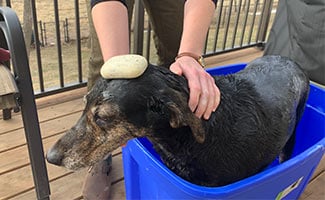
Before using this soap bar, I used liquid dog shampoo that came in a plastic bottle. Now that Ive used this bar of soap, Ill never go back. Using a bar of soap is so much easier than using a bottle of liquid soap because it frees up one hand to hold my dog while I use the other hand to scrub and lather my dogs skin and fur. This especially helps with getting my dogs belly and underside. I also like that this WashBar soap has zero waste. It comes in a cardboard box, so theres no plastic used. One bar of soap is equivalent to over 20 oz of liquid shampoo. This is important to me because I try to limit my plastic use in other items I purchase, so why wouldnt I do the same for my dogs shampoo.
Kimberly A., Canine Journal
2. Dont Forget To Brush
This step can easily get overlooked. Before bath time, prep your pup by giving them a thorough brushing to get rid of tangles and excess hair. Need a brush? Youre in luck. Weve recommended the best dog brushes for you.
3. Pick A Spot (& Stick To It)
Wondering how to bathe a scared dog? Consistency is critical when it comes to keeping your pet clean and calm. Bathing can be uncomfortable, so having a place they are familiar with will ease their fears or at least let them know what to expect.
A lick pad is a great wayto get your pup to sit still during a bath. Just stick the pad to the side of the tub or countertop (if your dog bathes in the sink) and add peanut butter. This combo will keep your pup distracted and entertained so you can focus on cleaning.
If you live in a smaller apartment, a bathtub with a handheld shower sprayer is sufficient. If they are smaller or a puppy, you could also use the sink. There are special tubs just for bathing dogs, but if you are already tight on space, the sink or tub might not be a good option.
Have an outdoor area and live where the temperature to bathe dogs outside is warm year-round? Then outside might be a better option, but make sure its on a flat, sturdy surface like concrete or a deck, so youre not counterproductively washing them in the muddy grass or yard. A kiddie pool can double as an outdoor doggy spa too.
You might also consider trying a hose attachment like the Aquapaw. As seen on Shark Tank, the Aquapaw has a soft, silicone brush with a handle on the end of the hose that allows you to control the water flow with a button on top. Its easy to grip and gently massages your pup while you wash them no need for a bucket of water or tub. Canine Journals founder had the opportunity to experience the Aquapaw in exchange for an honest review.
Our Personal Experience With Aquapaw![]()
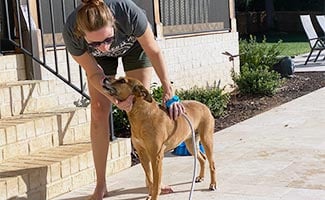
We attached this grooming brush to the hose outside, and it was so much better than anything I have ever tried for bath time. Our dogs preferred the gentle rub and brush to the typical cold spray of water from our shower wand. It was also fast and relatively painless for all. I will definitely use it again and recommend it to anyone seeking a less stressful dog bath experience.
Michelle S., Canine Journal
4. Gather Before You Lather
Once your pup is wet, youll have your hands full, so having everything you need nearby is necessary. Set aside a clean towel, a cup for rinsing (if need be), and treats for afterward (or during for good behavior). Never leave a dog unattended in the tub, and if youre outside, make sure your dog is contained or on a leash.
5. Some Like It Hot: Water Temp Matters
Can I bathe my dog in cold water? is a common question we hear.
Lukewarm-to-slightly warm water is ideal. Never use scaldinghot water, as it canburn your dogs skin. Think of what would be good for a newborn baby or a small child. Not too hot, not too cold.
6. Clean From Bottom To Top, Rinse From Head to Tail
Follow the instructions on the shampoo bottle, then lightly lather the soap in a circular motion paying particular attention to their paws and other places prone to dirt. Start with their feet and work your way up to their face last.
This will stop the soap from dripping into their eyes and ears and cut down on shaking. Rinse starting from the head and work your way down until the stream is clear. This helps the shampoo wash down and away from their sensitive spots.
7. Towel (Or Blow) Dry
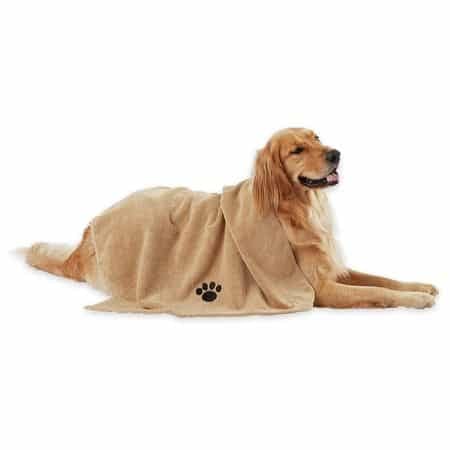
Covering your pup in a towel retains heat and lessens the chances of them shaking water all over you (and your house). If its cold or your dog has long hair that takes longer to dry, you might consider using a dog blow dryer to speed up the process.
8. Make It Fun!
Are you trying to figure out how to give a dog a bath that hates baths? Make it enjoyable! Bathing can be a bonding experience for both you and your dog. Take baby (or puppy) steps, introducing them to water and working up to a full bath. Dont take the plunge right away. Be patient and gentle. If your dog senses you are stressed out, they will be too. Make sure you reward with treats and show lots of love and affection.
8 Steps To Bathing Your Dog (Infographic)
To summarize, here are the eight steps for bathing a dog in a visual format to reference easily.

Watch A Dog Get A Bath (Video)
Check out this 90-second video to see an expert from PetCo bathe a Lab using some of the tricks and techniques we shared above.
Can I Give A Dog A Bath Without Water?
Looking for how to give a dog a bath at home without water? Its possible to use quick bath dog wipes to calm down the stink. They reduce bacteria and odors. Wipes are always good to have on hand, especially in the car for those dirtier post-dog park moments. Check out our reviews of the best dog wipes. You can also use a dog brush to get the grime out.
If your dog is dirty and you are thinking, can I bathe my dog everyday? No. But another option is waterless or dry dog shampoo. It can come in various forms, including spray, powder, or mousse, and is designed to leave your dog looking and smelling fresher without adding water. This can be helpful between baths or if your dog is scared of water.
Lastly, if your dog starts to stink up the house, you might want to try a pet odor-neutralizer.
How Often To Bathe Puppy Dogs
Puppies generally do not need to be bathed as often as adult dogs. Their coats are not fully grown yet, and they typically are not going outside as much (or around other dogs until they get their vaccination shots). You can bathe a puppy as needed if they get particularly dirty or smelly. As with any dog, if your puppy has any skin issues or allergies, you should consult with your veterinarian on how often to bathe them.
Other Ways To Improve Your Pups Quality Of Life
Just like humans like to be clean, dogs enjoy being clean too. The only difference is that dogs can lick themselves every so often they mostly rely on their pet parents to help with hygiene. In addition to bathing, you can improve their quality of life by brushing their teethand giving them a full groom regularly.
Tagged With: Grooming, Reviewed By Dr. Pendergrass, DVM
